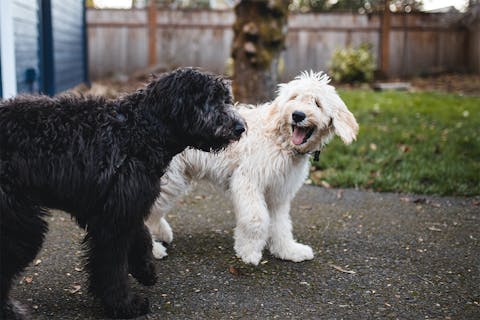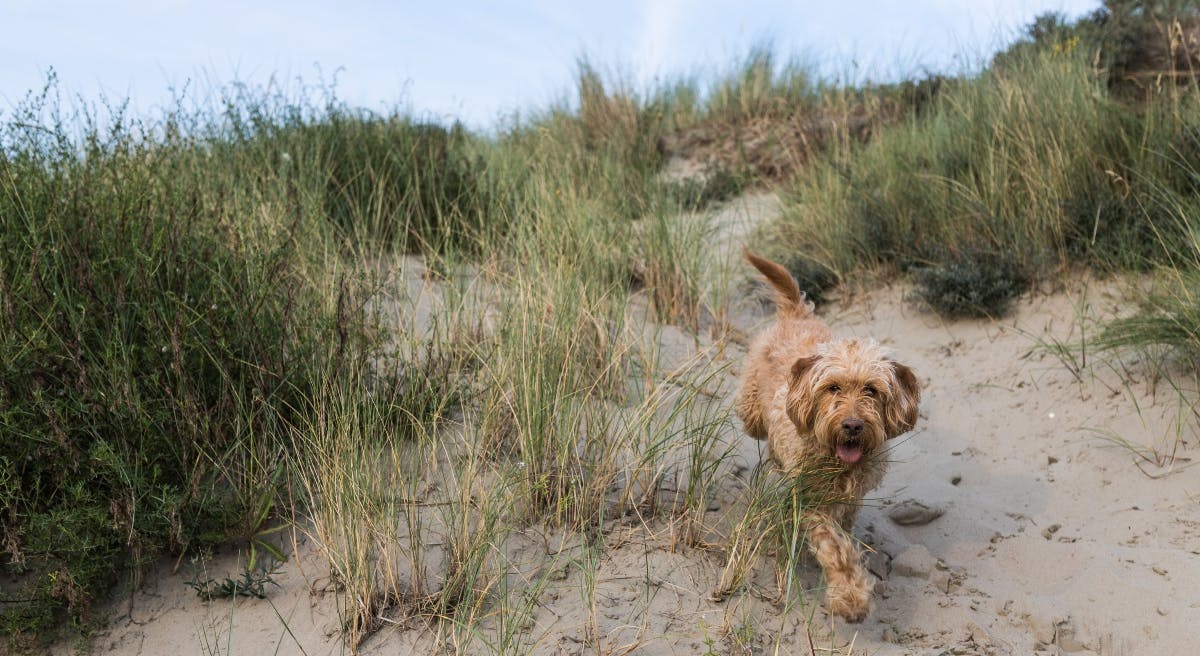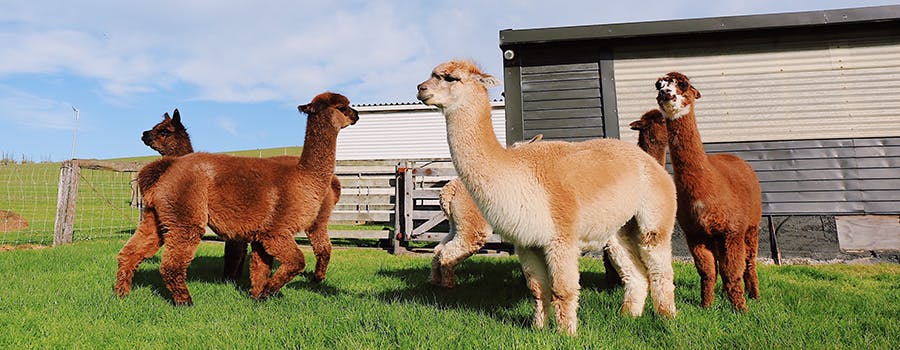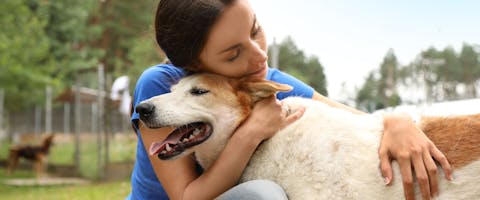Updated 15th August 2025
If you’re adopting a dog from a shelter, you’ll want to get as clued-up as you can on training a rescue dog, and how to help them settle into their new home. To make the transition smoother for everyone, follow our guide to house training a shelter dog, where we explore potty training, crate training and more.
Training a rescue dog: top tips
Be patient and give them time
- Give your dog time to adjust to their new environment, so give them time to sniff and explore, or retreat to a safe corner.
- Follow their pace when it comes to training and go as slow as needed.
Reduce initial anxiety
- Consider a pheromone collar or plug-in to help ease their initial anxiety.
- Try to be relaxed around your new dog and don’t introduce too many new people at once.
- Let your dog come to you and never force interaction - this will help to build trust.
Start basic training from the get-go
- Take initial training slowly, but establish boundaries and enforce house rules from the beginning.
- Praise your dog for the behavior you want to continue.
Reward your dog for good behavior
- Positive reinforcement training is regarded by professional dog trainers as the best way to train a dog, and experts strongly advise against punishing dogs for misbehaving.
- Provide your pooch with treats, praise and a scratch behind the ear when they behave in the way you’d like.
- Choose treats carefully, avoiding too many fatty treats.
- You may need to reduce their meals to avoid tummy upsets and unwanted weight gain.
- Stick to dog-specific treats so your pup doesn’t become unwell.
Establish a routine
- Stick to meal times, walkies, play and bed time at the same time each day to help them settle in and provide some stability.
- Keep everything your dog needs in the same place so they can find it easily.
Create a safe space
- Make sure your furry friend has their own safe space to retreat to in case a little bit of alone time is needed.
- Consider crate training your dog - this can be their safe space and it can help with house training.
Start with basic cues
- Let your dog settle in first before training basic cues.
- Begin with simple commands like ‘sit’, ‘come’, ‘down’, ‘stay’, and ‘leave it’.
- Remember your dog might already know a few cues, so try them out to observe how much they know.
- Short, frequent training sessions work best.
Learn your new dog’s body language
- It’s important to know your dog’s signs of fear, stress and overstimulation so that you’re able to adjust your training.
- Never push your dog to train if they’re showing signs of distress.
Trending posts
Purr-use some of the top blogs our members have been loving this month- Top male dog names for your new furry friendGot a new furry family member in your pack? Check…

- Top female dog names for your new fluffy palWelcoming a new pooch into your family? Explore…

- 250+ gray cat names your silver feline will loveRecently welcomed a fluffy gray bundle of joy into…

- What are normal pet sitting rates?Discover the average pet sitting rates for animals…

- Unique dog names to stand out from the packDare to be different with our list of the best…

How to house train a rescue dog
Establish how much they know already
Your rescue dog might have been partially house trained, so observe their behavior and use their response as a starting point for potty training.
- Try commands. Start by seeing if your dog responds to the commands of ‘go pee pee’, ‘go to the bathroom’, ‘go potty’, or ‘outside’.
- Observe body language. Notice if they indicate to you they need to go potty - do they scratch or whine at the door, do they hold it in until they’re allowed outside?
Corden off your home
To prevent your dog from pooping and peeing across your entire home, consider cordoning off areas with a baby gate to keep any accidents contained.
Establish a feeding routine
- Feed your dog at the same time every day.
- After they’ve eaten, observe your dog’s behavior to determine when they need to poop or pee.
Decide on a potty spot
- To give your rescue dog a good chance at house training, choose a space where you’d like them to go potty, and stick to it.
- Make sure the potty spot is easily accessible.
- Take your dog to this same spot to eliminate every time.
Take them for regular potty breaks
You’ll want to take them for regular pee and poop breaks (as often as every 45 minutes), especially after meals.
Use positive reinforcement
- Reward your dog with treats and praise when they eliminate in the right spot.
- If you catch your dog pooping or peeing on the potty spot off their own accord, praise them immediately afterwards.
Never punish your dog
- Negative reinforcement is never encouraged, and could be triggering for dogs with unknown or traumatized backgrounds.
- If you notice accidents in the house, never ‘rub your dog’s nose in it’.
- Simply continue with your house training routine and positive reinforcement.
Consider crate training
Crate training can help to differentiate between places for relaxation, versus areas for play, and areas for pooping or peeing. They create a safe space for your dog, and can encourage bladder control.
How to crate train a rescue dog
- Kit the crate out with a comfortable bed, cushions, toys and a crate cover.
- Leave the crate door open and let your dog explore at their own pace.
- Close the door for a few seconds and build it up over time.
- Reward your dog with treats and praise if they go in by themselves.
- Go slowly and observe your dog for signs of stress, as some dogs might associate the crate with punishment.
Benefits of crate training your rescue dog
- It provides anxious dogs with a safe space to retreat to.
- It can help to avoid some behavior issues and help with house training.
- It can help your dog to avoid separation anxiety.
How to socialize your rescue dog
- Introduce new people, places and environments slowly and only once your rescue dog is used to their new home.
- Keep socialization short and sweet - especially at the beginning - to avoid overwhelming your dog.
- Provide treats and praise to help make socialization a positive experience.
- Watch for signs of stress and anxiety.
- Gradually introduce them to other new experiences, like other dogs andpet sitters, as time goes on.
How to prepare for your first night with your rescue dog
- Decide where your dog will sleep before bringing them home.
- Set your dog up in a cozy bed in a room nearby.
- Provide treats when your dog gets into bed to positively reinforce the space.
- Kit your dog’s bed out with blankets and cozy toys.
- Use a pheromone diffuser to help reduce initial anxiety.
- Offer comfort if they’re upset, but don’t overdo it, as this can lead to separation anxiety.
Things to consider:
- If you let your dog sleep on your bed the first night, you’ll need to be prepared to do this every night (which might be off-putting for some pet sitters).
- Be prepared to be up in the night for a little while - your dog needs time to adjust.
How to help your rescue dog settle in
Ever heard of the 3-3-3 dog rule? Rescue dogs typically need three days to unwind from travel, three weeks to adapt to your schedule, and three months to fully settle into their new home. Here are some takeaway tips for helping your shelter dog settle in.
- Don’t overwhelm them – we know having a new dog is exciting, but it’s important to be calm and reassuring.
- Establish a routine.
- Be patient, take things slow, and give them space.
- Spend quality time together.
- Don’t make any assumptions about what your dog can and can’t do.
- Never punish them for getting things wrong.
- Keep visitors to a minimum.
- Provide them with exercise and mental stimulation.
- Consider using appeasing pheromones, sprays or diffusers to help calm your dog.
A shopping checklist to help prepare for your rescue dog
Make sure you’ve got all the necessary items before bringing your rescue dog home to make the transition from shelter to home as smooth as possible. Below find a list of things to get stocked up on before bringing home your new canine companion from the rescue shelter.
- Food and water bowls.
- Food – to start with, this should be the same food they ate at the shelter. Make sure it’s suitable for their age, packed with nutrients, and doesn’t contain anything they’re allergic to (if they have been diagnosed with allergies). If you decide to change your pet’s diet at any point, speak to the vet about the best way to do it.
- Healthy treats (essential for training and bonding with your pup).
- Poop bags (important!).
- Pee pads (in case they’re not house trained).
- Toys – puzzle toys, chew toys, and soft toys.
- A dog crate that can be used both at home and for traveling.
- A cozy dog bed.
- ID tags with your details on them.
- An adjustable collar.
- A leash and a harness.
- Grooming products including a brush and shampoo.
- A baby gate, if necessary.
Useful resources
- How to crate train an older dog
- How to house train an older dog
- Puppy training for beginners: how to train a puppy
- 10 good dog training books on behavior and training
- Best dog training apps of 2025: pricing & key benefits
- How to bond with your dog: 12 vet-approved ideas
- 14 reasons dogs are the best pets: benefits of having a dog

